
Post Survey Note: Thank you to all those who completed the survey. It’s no longer live, but you can see the final results in the article.
For the last couple of years I’ve been enjoying the TCLoc Masters degree at the University of Strasbourg. It’s been a really interesting time for me helping to fill in a lot of gaps and widen my technical knowledge around localization, and introducing me to the world of Technical Communication in general. This latter part was particularly interesting because half of our business at SDL relates to this; so having spent my time since 2006 working with our localization products it’s been an eye opener in many ways. I have done this in my own time and not as part of my job, but TCLoc does look like a course that’s tailor made for SDL employees!
The course work is pretty much all over now and I’m working on my dissertation which is the reason for this blog article today. I’ve chosen to question the effectiveness of voice recognition technology for dictation, compared to the use of machine translation, in particular neural machine translation. I have many opinions around this of course, but what I’m really interested in is your opinion as a group of professionals who work with this technology every working day. To get this I’m hoping you’ll spend a little time to answer the questions in this article, and I’ll try to explain the reasons for each question as I go. Each question is a simple checkbox, sometimes only one answer is allowed, sometimes multiple answers. If you have something different to say I welcome your feedback in the comments. There’s only seven questions, but thank you all in advance for sharing your views on this and helping me with this task.
An important point here is that this is not just for Trados Studio users! I’m interested in the feedback of all professionals working in this field irrespective of the tools used.
The Survey
Do you or don’t you use dictation?
To begin with I’m interested in how many of you actually use speech recognition for your translation work. Sometimes it sounds as though being able to dictate is something every translator wants to be able to do… but do they?
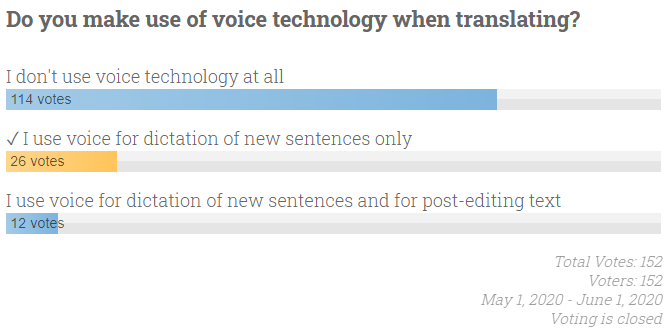
If you don’t use voice technology at all, then why is this? Certainly in the last few years we’ve heard from a very ‘vocal’ part of our profession who use it regularly.
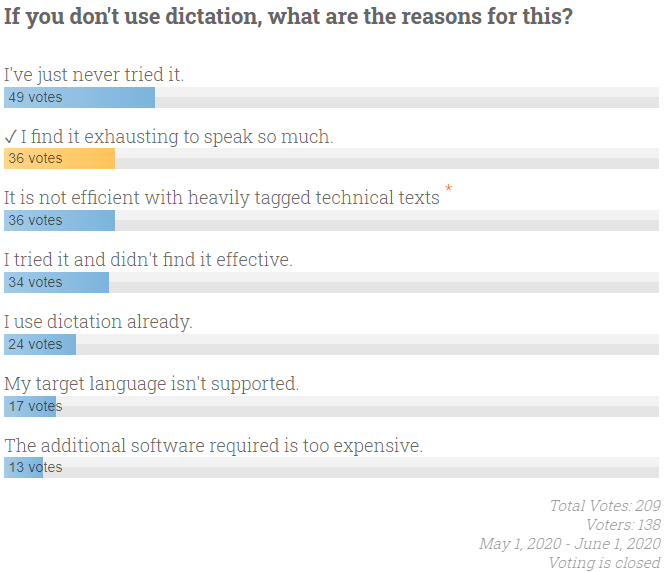
If you do use it then what is it that ensures you use this in preference to typing your translations?

What about Machine Translation?
I can still recall the times when the idea of using machine translation was considered laughable and very few professional translators would use it. Many were curious, and of course worried about whether or not this technology would replace them, but it was mainly the butt of a good joke! Today however things are different. Most translation tools provide a variety of plugins for machine translation and it’s probably fair to say that most translators working with CAT tools today take advantage of it. Or is it?

Some CAT tools provide the ability to work interactively with machine translation as well as supporting an ability to pre-translate and post-edit. So if you do use machine translation, here’s a few questions… tick all that apply.
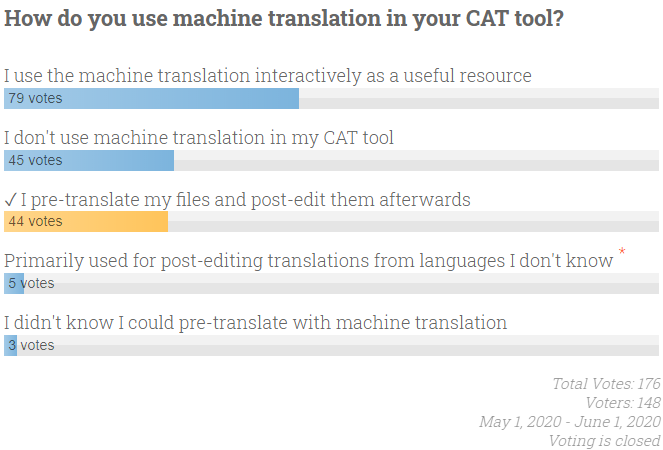
One of the benefits of neural machine translation is its fluency. The quality of the sentences have become incredibly good, especially for some languages, and this is the main reason we are seeing so many new solutions appearing on the market and also why so many translators have adopted its use today. But this is a double edged sword, because it’s much harder to spot the mistakes and neural machine translation will sometimes sacrifice accuracy for fluency. Because of this the processes in place for quality assurance need to be really good, especially when post-editing.
One way to make this easier and still retain your productivity is to use speech synthesis. What I mean by this is you can use voice technology in the form of text to speech to read the source, or the target, to you. This way, for example, you could listen to the source and read the target simultaneously while you are post-editing. Perhaps not a solution for everyone, but for professionals with the right skillsets it might be a useful productivity boost and assist with the quality control while post-editing.
So my questions here would be…
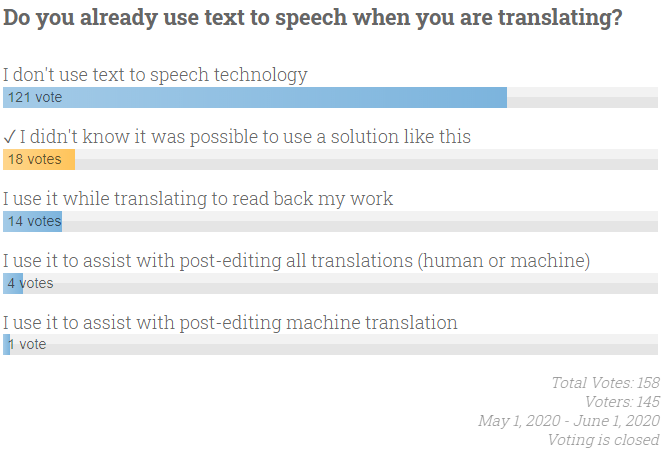
And my final question in this short survey is related to whether you, as a user of dictation solutions, think the ongoing improvements in machine translation will supersede the productivity gains you have seen through dictating all your work. There could be a variety of answers around a question like this so just tick all that apply and of course feel free to add in any additional comments of your own.
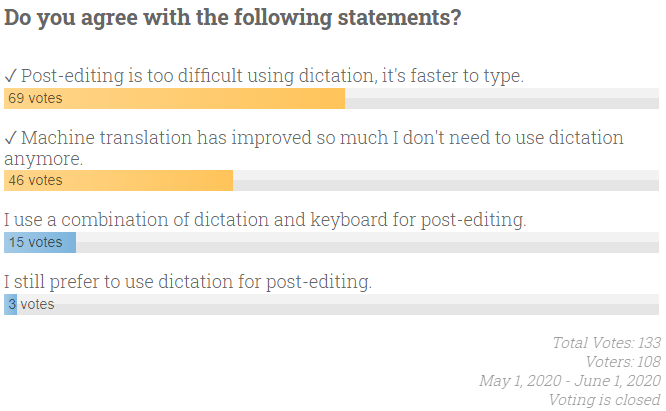
Survey over!
That’s it… and if you made it this far and have completed the survey thank you very much! Before you go, I added some sharing buttons at the end of this blog, so please feel free to share this through the social platforms you use and hopefully you can help me to improve the significance of the results with a larger data set to play with.
And of course if you have any opinions you’d like to share that won’t fit into anything I’ve said so far feel free to post your comments below… I’ll welcome the discussion.

I do use machine translation interactively, just not in my CAT tool.
Thanks Carole, that’s interesting. Do you use GT4T or something like that? Or just within a web browser?
Hi Paul,
This is Robin Bonthrone. The primary reason I don’t use dictation systems is that they are very intrusive, and I’m a touch typist anyway. I tried out Dragon many years ago (when I had actually met Janet Baker) and also found it very tiring. It actually interfered with my workflows.
Nowadays, I share my office with my wife, who works in a different field in the language industry. If I were dictating, it would disturb her. Likewise, when she is training interpreters, she moves to our upstairs office. I know there are some very vocal evangelists for dictation, but either they work alone (at home or in a separate office at their company) or they are just antisocial 🙂
That said, it could happen that the new world AC will give a lift to dictation vs. keyboard entry because more staff translators will be WFH and open-plan offices are set to disappear.
This is a very interesting question, though, and I hope you will be able to present the results of your survey at a future ATA conference.
Congratulations on your almost-Masters!
Be safe and stay healthy, Robin
Thank you Robin… definitely interesting how the world AC could affect the way people work like this. Good idea on the ATA… could be an interesting follow up after last years panel with Jost. Will have to see if they’ll let me… I won’t hold my breath!
Well done Paul to find something useful to do in these strange times! I’ve just signed up to a course teaching language teachers how to teach dyslexic students to learn a second language! Really interesting!
I’m sure you’ll wing it with this course, well done!
All the best,
Ali xx
Thank you Ali… I’ve been strange for years!! I like the idea of your course though, sounds very interesting and worthwhile.
Thanks for this interesting poll.
But you need more options for those of us who refuse to accelerate our own demise! I will not provide training for MT engines.
Hi Ralph, it’s a common misperception that using machine translation means you are providing training for MT engines. Very few MT providers recover the translation from the work you do and even then it tends to be limited to training for your own use. If you think about it, even though I’m sure all translators do an excellent job, I doubt any MT provider can trust in this.
However…. my questions are not related to this aspect at all. I’m really only interested in whether the advancements in machine translation have changed the perception of how useful voice recognition technology is for productivity gains.
Hi Paul,
This is a very interesting subject. Actually, I started using voice dictation (with different tools) because of some physical ailments (mainly, aching shoulders and forearms). Immediately, I found I was far more productive, with a netincrease of output (a 30% in words per hour, including review).
Although my ailments are gone, I still use this, but this time, for productivity reasons. Nevertheless, there is no gain in productivity if I use machine translation and voice dictation/recognition at the same time. Probably I would need more vocal training for that.
So for me it is either one thing or the other, depending in the project requirements, client needs, subject, etc.
Keep it on!
Pepe
Thanks Pepe… so machine translation gives you the same gains you see with voice?
No, I meant using voice recognition AND MT at the same does not increase productivity vis-a-vis MT alone.
Productivity differences between MT alone or VR alone depend on the nature of the source text, I guess.
Hello Paul,
Thank you for posting this. I would just like to suggest any similar poll in the future explodes the options for why translators use voice technology. The way I translate changes when I dictate and it is that qualitative change that is more interesting to me that quantitive changes in speed. Hard to explain in a few words but hope that is clear. There is a Facebook group “Translators who use Speech Recognition” for those interested.
David Hardisty
Thank you David, I appreciate your feedback. I deliberately wanted to keep this small survey short and simple and the comments section is good for adding more detail, as you have done, and I do understand where you’re coming from. The focus of my thesis is not so much on why translators use voice recognition software if it’s not to increase their productivity, but rather whether the need for better quality assurance processes as a result of using machine translation can be achieved through the use of voice synthesis. So text to speech rather than speech to text. This short survey is to help me with numbers to identify a few trends that will validate my theories… or not!
An interesting topic Paul.
Christian Alkemper gave a good presentation on how he uses text-to-speech for QA at a conference called TriConf in 2015.
https://trikonf.wordpress.com/programme/
He might have useful thoughts as I got the impression from the talk he uses it in his day-to-day work.
Thanks John… much appreciated. I was there 😉
I’m not convinced that I’m much more productive when dictating in terms of the actual output of an hour of dictating versus an hour of typing. But I’m less fatigued after dictation blocks, physically and mentally, and I can get a bit of exercise during dictation blocks (cycling, mostly).
Dragon doesn’t understand my Hiberno-English when I leave pauses between words, so I have to pause, think, and then dictate full sentences or at least large chunks. That time I spend staring into space, neither dicating nor typing, seems to improve the quality of my first drafts (apart from the riding/writing issues).
Thanks Sarah… another interesting aspect into why people might use voice recognition along with the feedback from David. I think he’s right that it would make for an interesting study… certainly I had never even considered the reasons you use it.